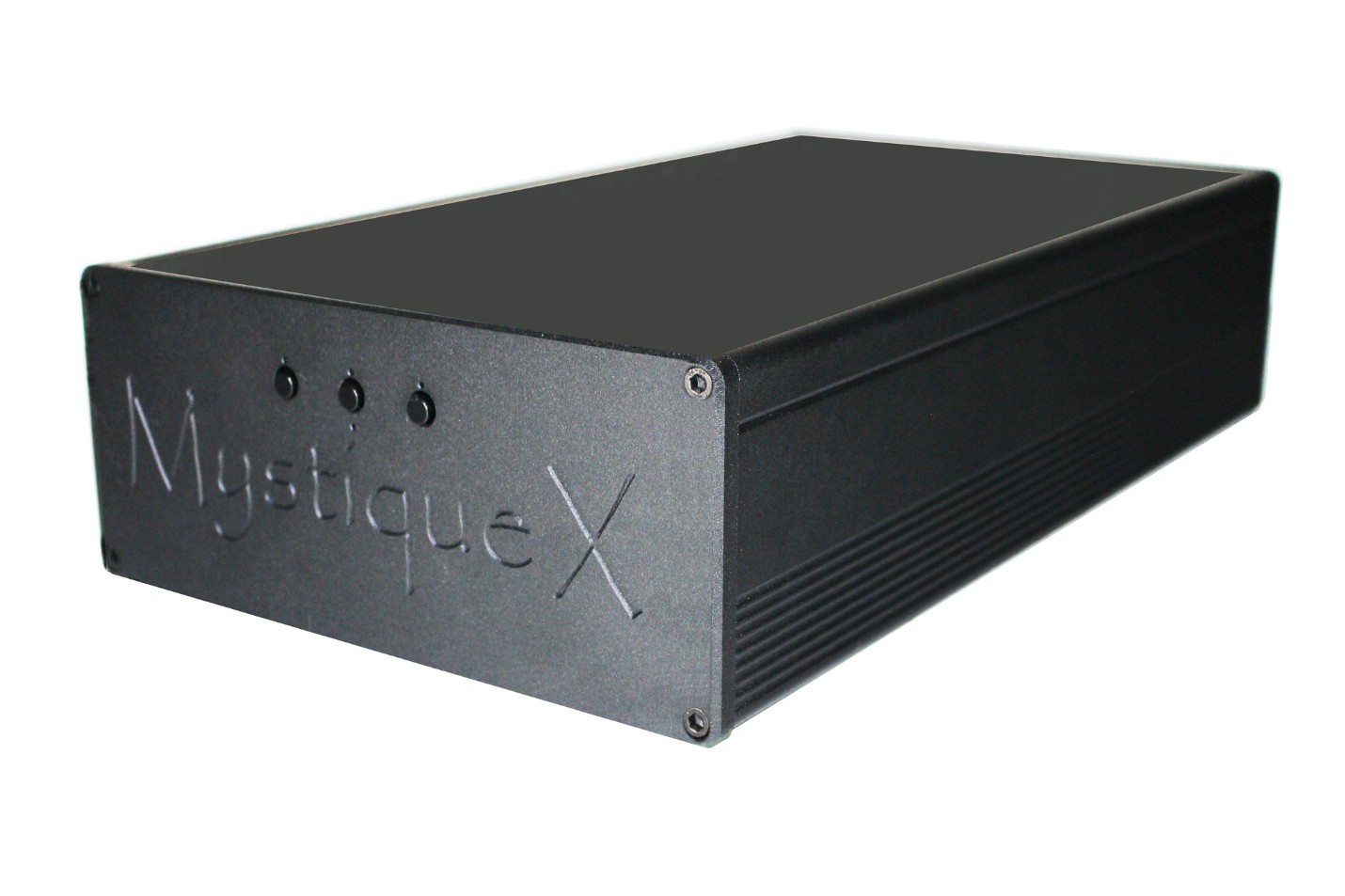Never did I think I would see the day that I would be able to write the phrase “Digital Calm” in a review. Let alone have it be the title of one. Up to this point, I only envisioned using such a term in the company with other oxymorons like silent noise, jumbo shrimp, exact estimate, and one of my favorites, original copy. But now, as Rafiki, the wise old baboon in Lion King, says, “it is time.”
From the moment I heard my first CD in 1980 on an NEC CD 803, one of five in the country that had been flown over from Japan for the CES show in Chicago, I knew we were in for a long dark time in the area of music reproduction. As you can imagine, “calm” was not my go-to word to describe the feeling I was left with after listening to music on that CD player for 30 minutes.
In the years that followed, we all know the efforts made by manufacturers to reduce or mask the effect that CD reproduction had on us. Upsampling, oversampling, single bit, sliding bit, FGPA, and on and on. While some were more successful than others in reducing the ill effects of CD reproduction, for the most part, they could have served the music better.
Fast forward to the present and the subject of this review, the Mojo Audio Mystique X SE. A piece that has been somewhat of a revelation to me. Of course, I could use all the audiophile buzzwords to try and relate the experience of listening to this component. Soundstaging, depth, harmonic structure, analog-like macro/micro dynamics, timbre accuracy, oneness, pace rhythm timing, blah blah blah, and yes, it would be deserving of copious praise on all these accounts and more. But you have read all of that before in reviews of other DACs. I’m afraid it would just come across as the newest member of the infamous DAC of the month club. And that would not be fair. This piece represents more than that. It has a calmness, listenability, and musical engagement that I have not previously heard in digital reproduction but regularly experience when listening to my analog front end.
While I have heard hints of this quality in other R-2R DACs, like the Border Patrol SEi I reviewed and the Denafrips Terminator Plus, none have elevated the sound in the area of depth, and information retrieval like the Mojo DAC has. It has a naturalness and musicality along with spatial information, precisely depth, that I have not heard in a DAC before.
The origins of this review start in April of this year at AXPONA 2022. My room was on the 14th floor, a display floor for exhibitors, including a few on my “hit list.” Including Rogers High Fidelity. My interest in Rogers High Fidelity was piqued by an earlier review from our own Adam LaBarge on the Rogers 65V-2 integrated amp, so I wanted to stop in and take a listen. ( link to Rogers review) Also exhibiting with Rogers were Alta Audio Speakers and Mojo Audio. This happened to be the first room I stepped into.
As I listened, I felt the Alta speakers were a bit underpowered by the Rogers and were not as expressive as I have heard them in other settings, but I was attracted to the overall quality of the music. It had very nice openness in the midrange, was not analytical/clinical sounding, and had a very natural “flow” to the music. I was intrigued by the sound of this digital source, so I sought out Benjamin Zwickel, designer of the Mojo Mystique X DAC.
I inquired about getting one of his DACs for review, and Ben explained that the Mystique X was a new product that was going into production and he would contact me when full production got underway. True to his word, a review unit showed up in late July, and I began my evaluations in August.
It was around that same time that I got the new Jay’s Audio CDT3 MKIII transport in for evaluation which, interestingly, is the same transport that Ben uses as his reference.
Long-time readers know I lean toward DACs that use R-2R decoding chips. I explain this bias in more detail in my review of the Border Patrol SEi DAC I did last year. (link to review )
Make no mistake about it, I am an analog guy at heart, but I continue to hunt for a digital front end that gives me the same, or close to the same, listening pleasure I get from my analog front end. If I could combine the musical satisfaction, I get from analog with the convenience and accessibility to music that digital offers, I would be one happy puppy.
Well… not to give the review away …but Jay’s Audio CDT3 MKIII transport, in combination with the Mojo Audio Mystique X SE DAC, has gotten me closer to that goal than I have ever been.
But I am getting ahead of myself.
Let’s do a bit of a dive into this DAC…
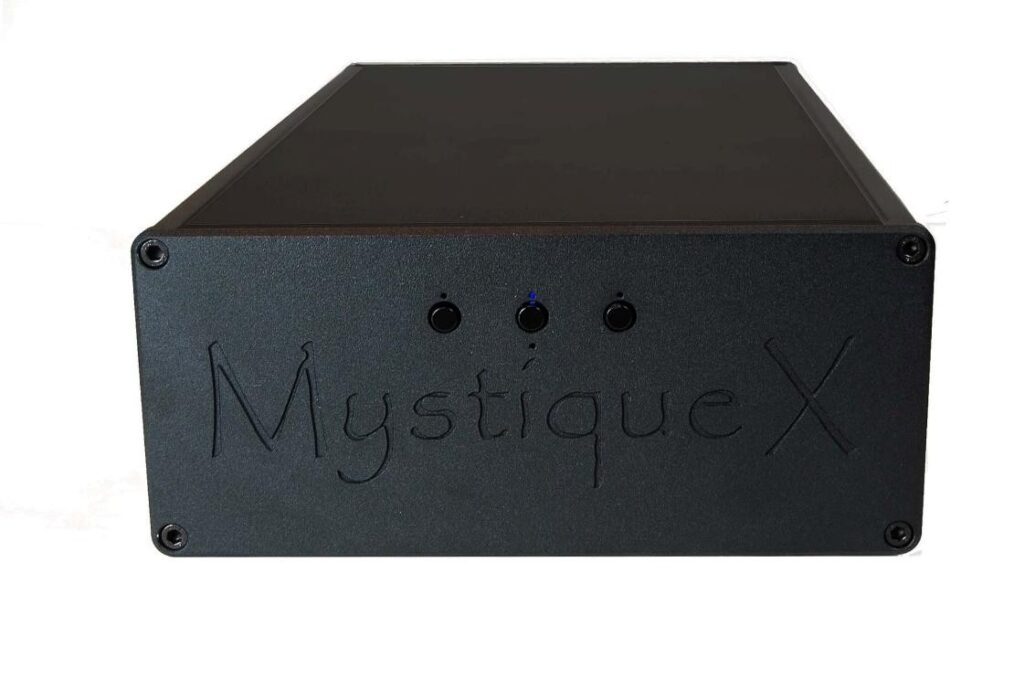
Component Details
The unit itself is a half-wide chassis that extends full component depth. Measurements come in at 9″W x 4″H x 16″D and 19 pounds. The spartan front panel has three buttons that allow you to choose the digital input you are listening to; AES, USB, or S/PDIF. A discrete blue LED resides above each button and indicates which input is active. There is a fourth red LED below the middle button that indicates a S/PDIF input error.
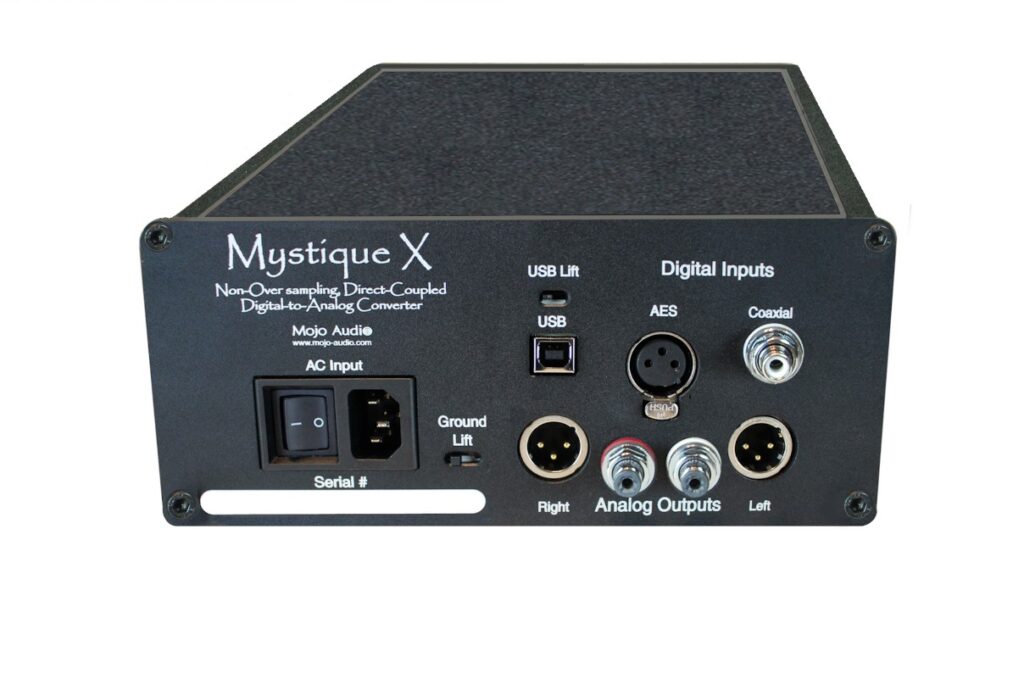
Moving around to the rear panel, we find a galvanically isolated, asynchronous, XMOS-compatible USB input. A USB lift switch is above the USB input. When engaged to the right, it is designed to remove 100% of the parasitic power supply drain from the USB input module and removes all internal clocking noise. The two digital inputs are the single-ended RCA coaxial S/PDIF and the balanced XLR AES input.
Below the digital inputs are the analog outputs, Balanced XLR, and Single Ended RCA. An interesting note in the owner’s manual points out that most listeners prefer the SE outputs over the balanced outputs, and I can confirm this in my listening sessions. The RCA outputs sounded more faithful to the music in terms of timing and coherency. Your mileage may vary, so try both and let your ears decide.
Lastly, we find the AC input and power switch, best left on 24/7, and a switch labeled “ground lift.” This switch, when engaged to the left, lifts the signal ground from the AC, Chassis, and earth grounds. It is recommended to be engaged unless you have some audible ground noise, in which case you would slide the switch to the right to remove the noise. The traditional fuse is replaced with a self-resetting thermistor which is said to be better both in terms of sonics and in terms of protection than any fuse, audiophile or not, that Ben has tried.
MYSTIQUE X Design
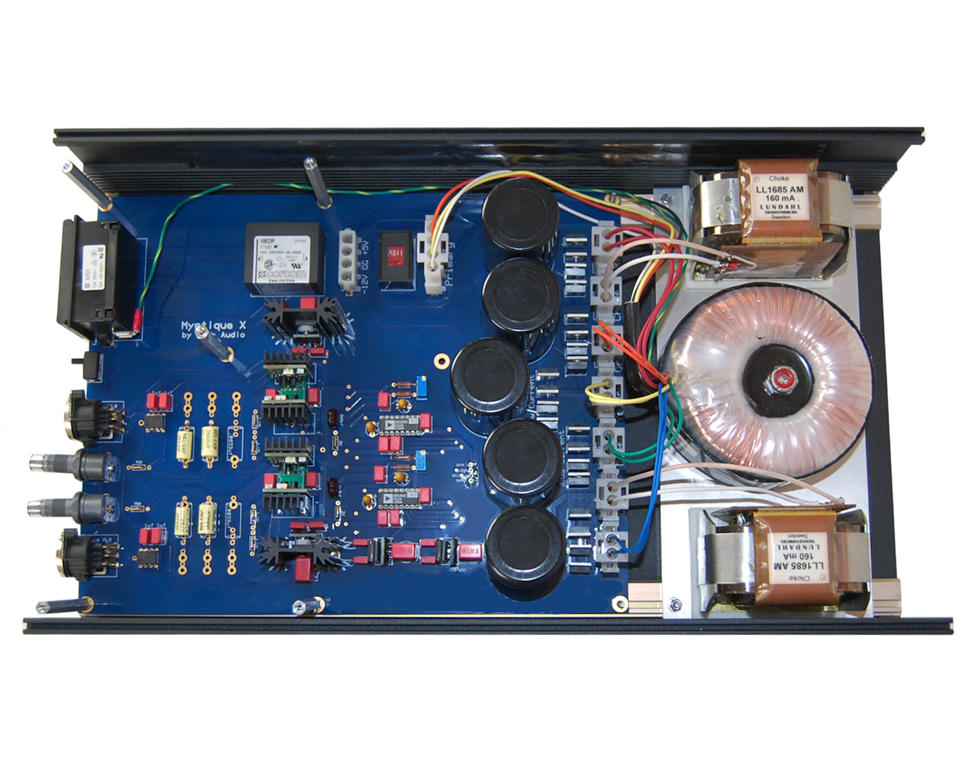
The Mystique X is an evolution of the company’s earlier EVO series DAC. The X stands for “extruded chassis.” An extruded aluminum chassis combined with anti-resonance materials to lower mechanical resonance from the different internal components. The combination of the new chassis and the damping materials is said to lower the noise floor by 5dB.
The Mystique is available in a standard version and the SE version, which is the subject of this review.
The primary circuit design is the same in the two units, which is a non-oversampling direct coupled R-2R circuit that uses no pre-digital filtering, digital noise shaping, upsampling, oversampling, or error correction algorithms.
According to Ben, this circuit is said to result in very natural “time and tune” and offers “effortless micro-dynamic and preserves micro detail, timbre, texture, and spatial clues that bring you closer to the musical performance. “
The SE version upgrades several vital components used in the standard X version and includes the following changes:
- Ultra-fast ultra-low noise zero recovery SiC Schottky rectification diodes.
- Vishay TX2575 “Nude” resistors matched to within 0.1% in the analog signal path.
- Five independent power supplies, each with 22,000uf Mundorf 4 pole capacitors.
- Lundahl amorphous core LC input chokes are used in the analog power supplies.
- Lundahl amorphous core input transformers on the S/PDIF and AES inputs.
- Additional anti-resonance and EMI/RFI shielding are added.
The Mystique X DAC uses a pair of 20-bit Analog Devices AD1862R ladder DAC chips, and while it can decode up to 24/196, it will truncate it to 20-bit. The hallmark of the design is the use of a massive choke-filtered power supply that features five independent power supplies to isolate each stage in the DAC. Nine Belleson SPX ultra-low noise, high dynamic regulators, are used to isolate power to the DAC chips, the clock, and the analog modules.
The analog output stage is directly coupled and eliminates output coupling capacitors or transformers and their colorations which can cause phase and time distortions. It features the use of the Staccato class A discrete op amps for the analog output.
If you would like further to explore this circuit design and Ben’s thinking, he has written three “white papers” that are very informative and make for good reading for those who want to take a deeper technical dive.
From mojo-audio.com
Suffice it to say that the two main tenants of Ben’s design philosophy are:
- A Choke/ Capacitor (LC) filtered power supply is the only design that can store both voltage and current.
- An R-2R ladder DAC decodes a digital signal, while a Delta Sigma DAC interpolates the digital signal.
Both tenants are fanatically pursued and developed in the Mystique X and X SE DAC.
You won’t find any unobtainium used in this piece, no magic wire, no whale oil-impregnated capacitors. No, it is simply a refinement and rethinking of decades of design experience and a melding of engineering knowledge with a love of music that has allowed this device to be created.
Break In
Mojo Audio is quite specific about breaking in the DAC, with a section in the manual devoted to this topic.
The manual describes that a break-in is only accomplished when the following conditions are met:
- The DAC is plugged into AC and powered on.
- There is a compatible digital signal connected.
- A bit stream is playing into the digital input.
- The digital input with the bit stream in selected.
- The analog output is loaded to your amp or a passive load.
Without the above conditions, there is no proper current flow either in the power supply or in the signal path, and without proper current flow, break-in does not occur.
Ben has also written an interesting article about component and wire break-ins.
The System
Once the 100-hour break-in was completed, I shuffled the Mystique SE into my main system.
Its USB input was fed by my ROON Nucleus using the EtherREGEN network switch and the excellent Audience Hidden Treasure Ethernet cable. My Jay’s Audio CDT3 MKIII transport fed the RCA S/PDIF input via a Gen 1 Mod Squad Wonder Link coax cable.
The main system is the Benchmark LA4 preamp into AHB-2 monoblocks or Pass Labs SIT 3, powering Acora Acoustics SRC-2 speakers. (review coming) Additional cabling was from Triode Wire Labs and Belden Iconoclast.
Listening to Bits
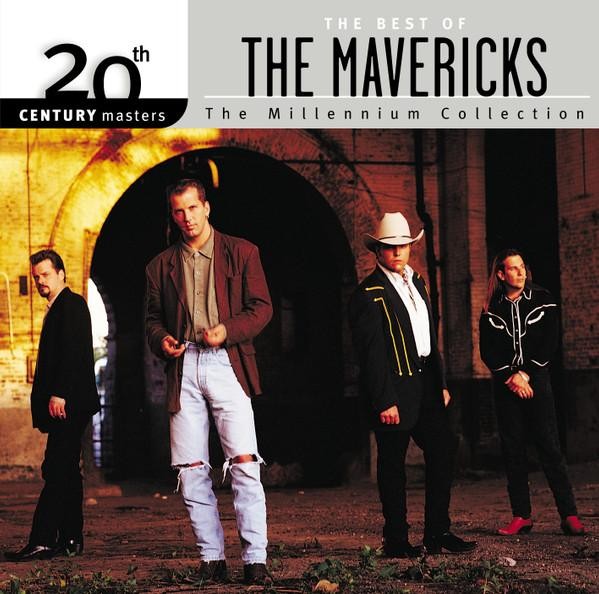
Produced by James Horner and Nick Lowe, I use the Blue Moon track to listen for overall depth, width, and layering of sound. Typically, most DACs compress the front-to-back depth available in the song. Not so with the Mojo Mystique X SE. From the moment I pressed play on my Jay’s Audio CDT MKIII transport, my listening room exploded with more depth, width, and layering than I had previously experienced. The decay of the vocals and instruments was exceptionally natural. When the guitar enters the song, set slightly back, to the left of the center, the tonality of the instrument is on full display with transparency and delicacy that is very lifelike.
Speaking of guitar, I moved on to another standard I frequently pull out for component evaluations.

I enjoy the Stairway to Heaven track musically, and I love how it moves from a very simple opening to a highly complex crescendo. The ability of the Mojo DAC to expose the tonality of the opening guitar was right on point. When the song moves into the two guitars playing in juxtaposition, the artistry was easy to follow and appreciate. The tone of each guitar quickly stood out, and I found myself mesmerized by the guitar playing. The naturalness of the hands taps on the guitar body sounded right. You could discern the cavity of the guitar and the wood nature of the sound. The timing and flow of the music were captivating. I have heard this song many times over the years, but I have yet to have it involve me more or sound better in my room.
Next up was another “go-to” recording.

Jacintha’s vocal on The Thrill Is Gone is offered up in a way that allowed me to easily decipher her vocal inflections and pure tone. The decay and “ringing” of the vibraphone were very natural, and the brushwork on the drums was delicate at times and dynamically expressive at others. With depth and body that I don’t typically associate with Digital reproduction.
All three examples and the hundreds more I listened to over the three months I enjoyed the unit revealed a DAC that consistently produced music that sounded closer to analog reproduction than any DAC I have previously experienced.
I will readily admit that “analog sound” may not be everyone’s cup of tea, but if you are a vinyl devotee, this may be the DAC that turns your head.
Lessons Learned
I wrote an article more than 15 years ago that posed the question… Do you listen with your eyes?
It was titled Eyes Wide Shut and was about a digital component that was groundbreaking at the time where I explored if it was “possible to listen with your eyes wide open?”
Listening to the Mojo Mystique X SE triggered me to remember that article and what I felt when I wrote it.
I want to paraphrase that article to now apply to the Mojo Mystique X SE DAC because I believe this DAC rises to the level of being an essential moment in my 40-plus years of listening experience.
In the article, I talked about two lessons I learned.
Lesson One…
It’s all there ….. on the CD ….. the seamless sound stage width and depth, the ambient cues, including leading-edge dynamics and decay. The retrieval of low-level listening clues. All the hallmarks of analog listening are on the silver disk to be retrieved. You need the right device. This piece achieves that magical combination of the best of analog and the best of digital and blends them into a simply intoxicating listening experience better than any DAC I have heard to date. Yes, it can be done.
Lesson Two…
Have you ever wondered why the experience of listening to reproduced music is more believable with your eyes closed? I have always subscribed to the theory that if you shut down one of your senses, you increase the sensitivity of others. By reducing the visual input, you free your brain to concentrate on the sound and increase your ability to experience the music with less mental distraction. In essence, you hear better, much like a blind person elevates their remaining senses to compensate for the loss of vision.
I have modified my thinking on this subject to include another reason. We close our eyes not to hear better but to allow our brains to fill in the blanks. A sort of “mental error correction system.”
Until now, I’ve always had to close my eyes to allow myself to believe the instruments and performers were in the room. I had to let my mind “paint in” the missing cues that would have me believe I was hearing an actual instrument or performer. I would have to keep my eyes closed lest the “illusion” would be ruined.
When I opened my eyes, the musical reproduction needed more convincing to override my visual input. My eyes would always win the contest, and my brain would conclude the performance was not real.
The Mojo Mystique X SE DAC allowed me to use the least amount of “mental error correction” I have ever had to apply when listening to a digital source. This, in turn, meant that I could relax and listen to music, something I regularly experience with Analog but rarely with Digital.
There were moments with the Mojo Mystique X SE DAC when I experienced music reproduction that was so convincingly lifelike I could stare at the spot the instrument or vocal should be, and the clues were such that I felt I could “see” the instrument or performer. The clues were so “real” that instead of the visual clues easily overriding the aural clues, I now at least had an even battle between the two.
It is pretty discerning to stare at a space and to have your eyes tell you nothing is there but to have your ears tell you something Is there. Disconcerting yes. But also a musical revelation. One, I dare say, that you would quickly adjust to.
Conclusion
Is this unit the last word in digital? Of course not. Have I listened to every DAC out there? Of course not. What I can tell you is that if your primary focus is on analog and you have been taking unfulfilling rides on the DAC merry-go-round searching for a digital component that will get you more involved with your music and less involved with your equipment, the Mojo Mystique X SE DAC may be the ride you want to try.
Just like vintage wooden roller coasters that offer something unique to the ride experience that newer metal coasters can’t convey, this “old school” DAC takes me to a musical place that new-fangled DACs haven’t been able to get me to.
Frankly, the highest praise I can give any audio component is to say that it can, for a moment, render the believable suspension of reality.
And so it was with the Mojo Mystique X SE DAC.
So yes, Rafiki….. “It is time”…
Mojo Mystique X SE DAC $9,999.00
Mojo Mystique X DAC $7,999.00
ANALOG SOURCE:
- AMG Viella 12JT Turbo turntable /tonearm & VIV Labs Rigid Float Tonearm
- Holbo MkII air-bearing straight-line tracking Turntable
- Audio Technica ART 20, Benz Micro LP-S MR cartridge & Grado Statement 3, HANA ML Mono MC Cartridge, Denon 103R
PHONOSTAGE:
- Mod Squad Phono Drive
- Tom Evans Groove+ SRX MK 2.5
- Coincident Signature Phono
- PS Audio Stellar Phono
DIGITAL SOURCES:
- Jay’s Audio CDT3 MKIII transport
- ROON Nucleus
- McCormack DAC-1 Platinum
- McCormack SST-1 CD transport
NETWORK:
EtherREGEN network switch
OPEN REEL:
Studer A 810 with Flux Magnetic Heads optically aligned by JFR Magnetics and direct-wired into a King/Cello tape preamp
LINE STAGE:
- The Truth v.3 (passive)
- Benchmark LA4
- McCormack ALD1 Khozmo HP
POWER AMPLIFIERS:
- Pass Labs SIT 3
- SMC Audio DNA 0.5 G21 Ultra Plus
- Benchmark AHB2 monoblocks
- Quicksilver MS190
SPEAKERS:
- Acora Acoustics SRC-2
- Acoustic Zen Crescendo II
CABLES:
- Audience
- Triode Wire Labs
- ASI Liveline
- Belden Iconoclast
A/C POWER:
- Dedicated 20 amp lines
- P.I. Audio UberBUSS & DigiBUSS II
- outlets from Audience, Jena Labs, P.I. Audio.
ACCESSORIES:
- SMc Audio UFO Isolation Base
- Stillpoints Ultra’s
- Apertures & LPI
- VPI Bricks
- HRS Turntable base

